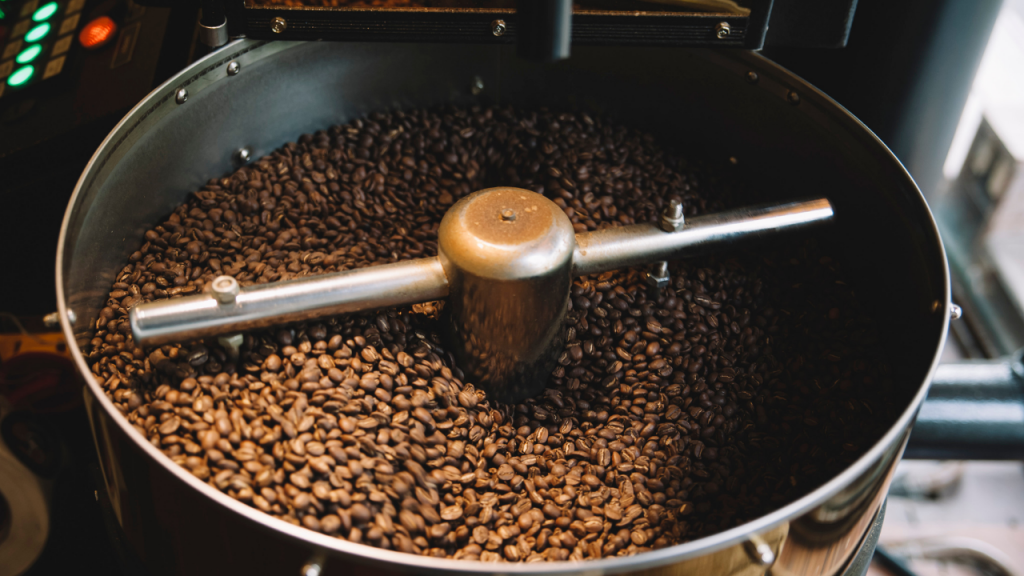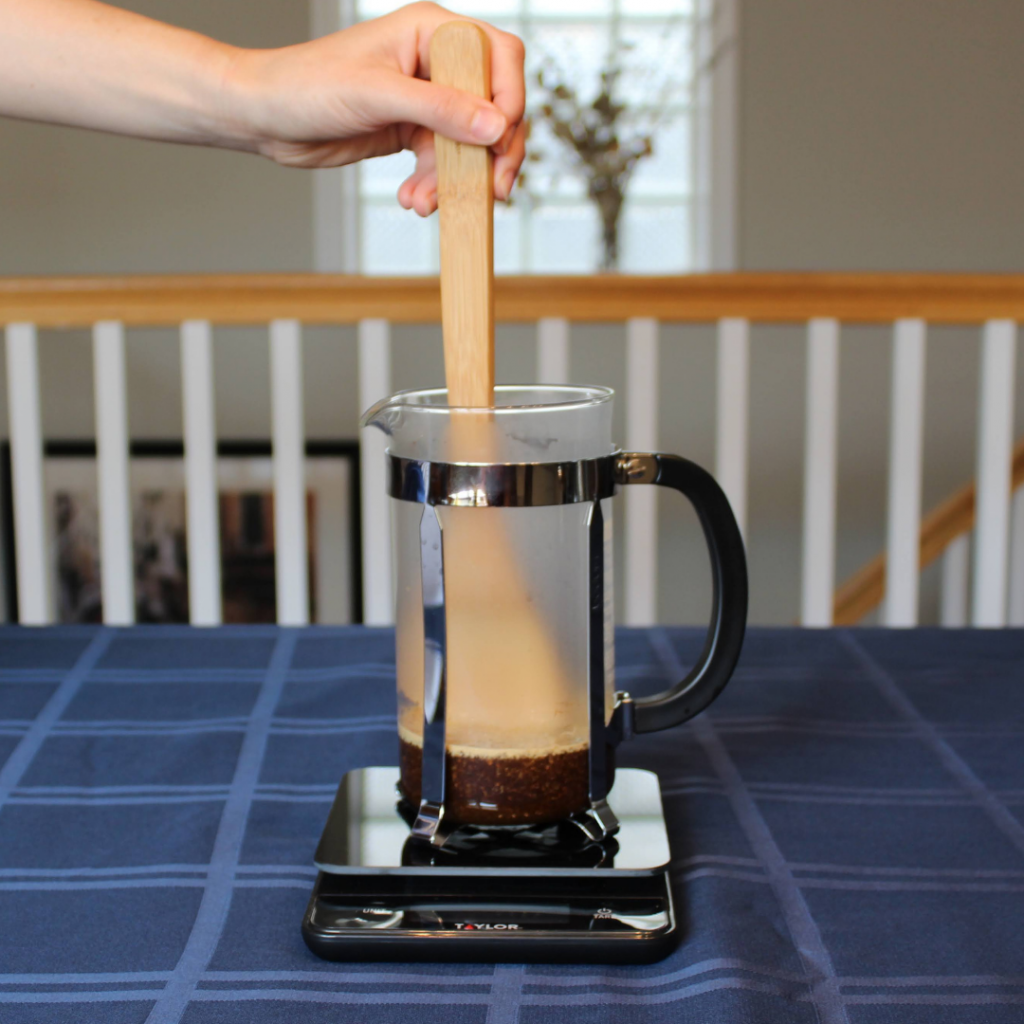You probably heard the word “bloom” used with coffee without any explanation of what it means. It’s more confusing when bloom is used as a noun (“the coffee bloom”) and a verb (“let’s bloom coffee”).
I’ve got you. Here’s exactly what coffee bloom means: the coffee bloom is the carbon dioxide that escapes freshly roasted coffee when it first contacts hot water. Adding a proper bloom stage to your brewing will improve your coffee’s flavor profile.
Today, I’ll teach you the basics of the bloom and how to bloom coffee depending on your brewing method.
The Basics of the Coffee Bloom
The bloom happens when hot water first touches the coffee grounds. The hot water causes carbon dioxide (CO2) to rush out of the coffee grounds. As the carbon dioxide escapes, the coffee grounds will rise, which looks like a “bloom” and hence the term. The rising coffee grounds are also called “turbulence.”
What Causes The Coffee to Bloom: Roasting
The carbon dioxide builds during the roasting process when harvested green coffee beans are heated to over 300 degrees Fahrenheit.
During the coffee roasting process, sugars and proteins interact in what is known as the Maillard reaction. Heat changes the amino acid structure of coffee molecules and creates all the complex flavors that we expect in our morning cup. The Maillard reaction happens in all cooking processes, and it causes the browning and flavor in seared meat.

Carbon dioxide also builds during the Maillard reaction and continues to build as the roast darkens. Once the roast is complete, carbon dioxide escapes the coffee beans. Most carbon dioxide leaves during the first 10 to 14 days of this degassing process.
Degassing slows after this initial period but continues well after the roasting process. The ongoing degassing is why coffee bags have one-way valves. Once you grind the coffee, it exposes more surface area for carbon dioxide to escape, and hot water causes the remaining gas to escape the coffee bean, which leads to the bloom.
The Importance of the Coffee Bloom
You should always take the time to bloom coffee (now we’re using bloom as a verb!). There are two main reasons:
- Carbon dioxide tastes bad, and you don’t want your coffee to taste like carbonated water.
- Carbon dioxide repels water, preventing the full extraction of coffee flavor.
In short, blooming coffee will make it taste better. Properly extracted coffee has a rich, sweet, and aromatic taste. Under-extracted coffee tastes nutty, sour, and watery. We recommend the Barista Hustle, which shows the full spectrum of flavor across extraction levels.
How to Bloom Coffee
Start with ground coffee in your brewing device. Next, add two parts of water to each part of the ground coffee (if you don’t have a scale, pour enough water to submerge all the coffee grounds barely). The grounds will rise, and carbon dioxide will bubble out of the top. Wait 30 seconds for full bloom. Then continue the brewing process as normal.
It’s important to note the water used during the bloom stage is part of the total water for the brew. The 30 seconds is additional time for the brew itself.
Here’s the blooming technique depending on the brewing method.
Pour Over
A coffee blooming is most important for pour over devices like a Chemex. In a pour over, the hot water, by definition, runs through the grounds once. This leads to a nice full extraction and flavorful, yet clean, cup. Carbon dioxide works against extraction by repelling water on its way through the filter. Worse, the turbulence causes water to run down the sides of the filter and pushes the coffee grounds up the sides of the filter, which seriously reduces extraction.
For a standard Chemex with 50 grams of coffee, pour 100 grams of water in circles starting close to the edge of the coffee and working towards the center. The bubbles will form after the grounds rise, and the bloom should take 45 seconds in total. Then complete the normal pour over process. The grounds should lie flat within the filter if done properly. The flat grounds show the carbon dioxide has escaped and there is no turbulence.

French Press
The bloom is straightforward for a French Press. Pour in 100 grams of water per 50 grams of ground coffee. Stir the coffee with a wooden spoon for 10 seconds and let the brew bloom for 30 seconds. Then continue the brewing process. See our French press brew guide for more details.

A bloom stage is less important for a full immersion device like a French press. The grounds are in contact with the water the entire time, unlike a pour over device. I still find French press coffee tastes better with a 30-second bloom. You can see the grounds rise using a light/medium roast:
Automatic Drip Coffee Makers
You can make the usual drip coffee taste a little better with a proper bloom. First, prepare the batch as usual and remove the pot. Next, pour some additional hot water on the filtered grounds in the basket and wait 45 seconds. Then replace the pot and brew the coffee as normal.
There is a second way to bloom drip coffee without the extra hot water. Prepare and start the drip coffee maker without the pot and let the filter basket fill up halfway with hot water. Stir the grounds a few times to let all the carbon dioxide escape. Then replace the pot, and the filter basket will drain along with the rest of the coffee.
Make sure your filter basket has a valve that prevents coffee from draining without the pot (most do). I’ve never tried the second method because I worry about a potential mess! But, it’s a good way for the bold amongst us.
There’s also a third “option”: buy a premium drip coffee maker with a coffee bloom function! All the simplicity of a drip and better flavor.
Cold Brew
The “hot coffee cold brew” method adds a bloom step to our cold brew recipe. First, add hot water (195 to 205 degrees) in a 2:1 ratio to the coffee grounds. Stir and wait for 45 seconds. Then add the remaining water at room temperature and store it for 12 hours or 24 hours in a refrigerator. This brings out more brightness in a cold brew coffee.

Fresh Coffee Versus Ground Coffee
The size of the bloom is a great way to measure freshness. Fresh coffee = more carbon dioxide = big bloom. If you don’t see a nice rising bloom, your coffee is probably stale ☹.
This happens because carbon dioxide comes from the roasting process, and coffee starts degassing right away. Freshly roasted coffee always has the most carbon dioxide and the largest bloom. The more time passes, the less carbon dioxide, and the smaller the bloom.
Ground coffee has more surface area for the carbon dioxide to escape and speeds up degassing. That may sound like a nice way to avoid the extra 30 seconds at the start, but remember that more compounds escape ground coffee than carbon dioxide. Aromatics and other volatile compounds give the coffee a lot of its sweet flavor and will escape as well. We always recommend buying whole coffee beans and grinding them right before brewing.
Most of the degassing will occur in 10 to 14 days after roasting. Bags seal flavor for some time but don’t expect a bloom for coffee that has been unsealed for over two weeks or roasted more than two months ago.
What Else Affects the Coffee Bloom?
There are a few more factors that affect the coffee bloom:
- Roast: dark roasts build more carbon dioxide during the longer roasting process and have a bigger bloom.
- Temperature: hotter water causes the beans to release more gas, reducing the bloom.
- Humidity: gas will escape more quickly in dry environments.
- Hardness: harder beans, like Robusta, release gas the slowest.
- Origin: some origins are known to have larger or smaller blooms.
What Next?
You know everything there is to know about the coffee bloom – a major step to brewing better coffee. Now check out the rest of our coffee brewing guides for more info on making the best coffee.




